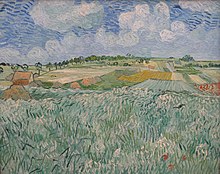| Plain near Auvers | |
|---|---|
| German: Ebene bei Auvers | |
 | |
| Artist | Vincent van Gogh |
| Year | 1890 |
| Medium | oil on canvas |
| Dimensions | 73.5 cm× 92.0 cm(28.9 in× 36.2 in) |
| Location | Neue Pinakothek, Munich, Germany |
Plain near Auvers (original title: Ebene bei Auvers) is an oil on canvas painting created in 1890, by the Dutch post-Impressionist painter Vincent van Gogh. [1] It is on permanent display at the Neue Pinakothek in Munich, Germany. It was acquired in 1929 from the art market Kunsthandel.
Contents
As the title implies, van Gogh painted the work while living in Auvers. [1] At the time, the artist while undergoing treatment for depression with Paul Gachet. [1]